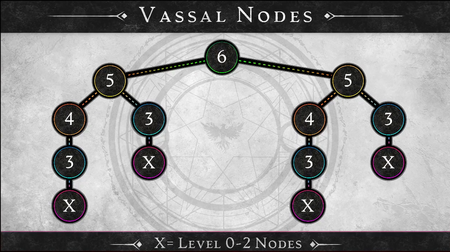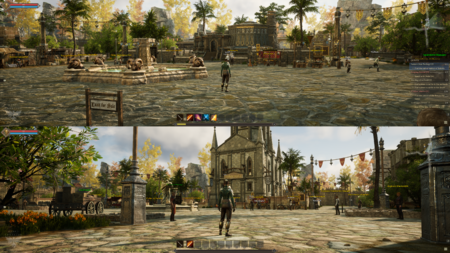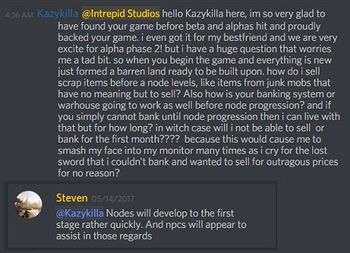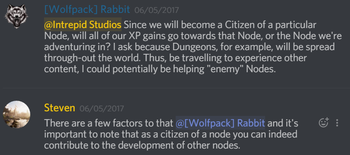Node stages
Nodes advance by collecting experience from the actions of players nearby. As players complete content inside of a Node’s Zone of Influence (the area around the node), they contribute that experience toward the Node’s development. The experience given to the Node may then be modified based on certain Events and Accomplishments. When a Node reaches the experience required, it undergoes the process of advancing to the next stage. There are a few exceptions where a Node cannot advance even though it has the required experience - most commonly, a Node can not advance if a Node is a Vassal of another Node and would advance to the same stage as its Parent Node.[1] – Margaret Krohn
Nodes have seven (7) stages of advancement, with experience thresholds for each stage. When a Node reaches the experience required for its current stage, it advances to the next stage.[2]
| Node stage.[3] | Symbol | Alternate name.[4] | Timeframe to advance.[3] | Player housing.[5] | |
|---|---|---|---|---|---|
| 0. | Wilderness | - | |||
| 1. | Expedition | Crossroads | Few hours | - | |
| 2. | Encampment | Camp | Many hours | - | |
| 3. | Village | - | Few days | Small houses | |
| 4. | Town | - | Many days | Medium houses | |
| 5. | City | - | Few weeks | Large houses | |
| 6. | Metropolis | Metro | Many weeks | Mansions |
Node advancement
Citizen and non-citizen player activity (questing, gathering, raiding, etc.) within a node's ZOI counts toward that particular node's advancement (progression) to a higher node stage.[1][3]
The advancement of a node unlocks its unique content, which comes at the cost of locking out an increasing ring of neighboring nodes from progressing to the next stage.[7]
- Nodes advance to the first stage quickly. This enables NPC services such as vending or banking items.[8]
- The more advanced the node is, the larger its ZOI becomes.[9]
- Less advanced nodes (referred to as vassal nodes) that fall within a more advanced node's ZOI can still gain XP, but must remain at a lower advancement stage than the dominant node.[10]
- The vassal system begins when a node hits Village (stage 3), but neighboring nodes starting from Expedition (stage 1) also block the growth of their immediate neighbors.[11][12]
- Certain quests, such as story arcs, may not be able to be turned in after a node has advanced.[13]
- The territory expansion algorithm takes into account the nearest coast, neighboring nodes, and the heatmap of players in surrounding areas over the last weeks or month.[14]
- Due to the way the progression algorithm calculates territorial (ZOI) expansion during node advancement, there is a small possibility that two nodes of the same stage end up being close to each other.[15]
- The way that the algorithm expands the territories takes into account a few things: One it takes into account the coast like where's the closest coast. Two it takes into account the neighboring nodes so it can take over and essentially vassal state those nodes, but what's more important is essentially the initial population based on like how players choose their races. Because we have nine different races and four different starting points that branch out, each server's population density is going to dictate essentially the first few nodes that are highly populated and then that initial seed is what's going to determine the node structure as it moves inland into the into the world essentially; and based on the performance and successes of different sieges will determine which nodes that got locked out from the previous the initial advancements what nodes can now be available to advance further. So I really think that with so many variables that are present in the equation of how nodes advance and stay existing with the more variables you have, the higher likelihood there is for there to be a significant diversion in world progression.[14] – Steven Sharif
- Normally the algorithm that's applied to the node territorial expansion will prevent significant nodes from being in close proximity to each other... There could be a perfect storm where all of the algorithmic progression of territory leads to having these nodes very close to each other because there's certain requirements that should that need to be available to satisfy node vassal takeovers; and it's possible that two nodes would never take each other over as vassals and end up close together and spanning their territories in opposite directions: The Tale of Two Cities thing.[15] – Steven Sharif
- A node does not receive XP from the nodes within its ZOI until these nodes have reached their cap.[10]
- Node experience gain opportunities will be equitable across the four node types.[17]
- Different people have different resources invested in nodes progressing and it would be a little "gamey" if you could know exactly what was necessary at that point because that would disincentivize people from participating.[18] – Steven Sharif
Node advancement spawns a series of animations and visual effects (within the footprint of the node).[19][1]
- Players within the node are teleported to a safe location, likely a respawn area near the node.[19][20]
- Supplies will spawn around the node and system driven caravans are spawned to bring these supplies into the node. These caravans are not able to be attacked.[19]
- NPCs will begin construction activities.[19]
- Players outside the node will see the new facade of the node pop into existence as the node advances in stage.[19]
- The Development Area of a Node is where civilization will appear as the Node advances. As the Node Stage increases, different buildings, NPCs, and services will become available in the Development Area. The higher the Node Stage, the more complex and populated the Development Area becomes. Development Areas will also vary depending on the Node Type - Economic, Military, Scientific, or Divine.[1] – Margaret Krohn
Vassal nodes

This vassal mode structure tells you what it looks like for a sovereign at a level six metropolis stage; and what it can control at a maximum vassal network is two level five nodes, of which a level five node can control one level four and one level three as direct vassals; and then the four can control a three; and every three can control a one or a two. Now if the three gets removed through siege, the one or the two is removed as well. So that's an important distinction between the three's vassals, which technically isn't really a vassal relationship because there's no citizenships possible. Those vassals don't exist between three and X, but they do exist between four and three, five and four, and six and five. And what this also allows is that because there are 85 nodes that are within the world, we have a buffer zone of about 20 nodes that lives in a max server state. So if you had maximum five metropolises form in a world, you will have a number about 20 nodes that can live alongside those metropolis networks; and when or if a metropolis falls, that extra cushion of nodes around the five metropolis structures allows for the map to be redistricted in a way that is unique. It doesn't mean that one of the fives is just going to pick up where the last six left off and form the same exact metropolis structure. From a territory perspective it has ancillary nodes to play with and expand towards that redistricts the map, so that if a metropolis falls there's a significant difference in the layout of the world and the layout of these almost nation-like territories.[21] – Steven Sharif
Village (stage 3) or higher nodes enslave nearby nodes, converting them into vassal nodes.[2][12]
- A Metropolis (stage 6) can control up to two City (stage 5) nodes. A City (stage 5) can control one Town (stage 4) and one Village (stage 3) node. A Village (stage 3) can control an Encampment (stage 2) or an Expedition (stage 1). If the Village (stage 3) gets destroyed through a siege, its dependant Encampment (stage 2) and Expedition (stage 1) nodes are also destroyed.[21]
- There is a layer of intricacy between how the neighboring nodes advance and what potential parent structure they have in the vassalship tree.[22] – Steven Sharif
- Vassal nodes gain benefits from their regent node (also referred to as sovereign node or parent node) even if the node type of the parent is different to the vassal.[23][24]
- It is not a bad thing to be vasseled, it is a good thing to be vasseled. It brings many benefits from the Sovereign, which is the ultimate parent of that vassal network down to the vassal node itself; and it allows that vassal node to even live outside of its normal mechanics. You get to adopt some of the benefits that the node type of your sovereign is, even if your node type as a vassal node isn't the same.[24] – Steven Sharif
- Regent nodes collect taxes from their vassal nodes. These taxes cannot be taken by the mayor or other players.[26]
- Vassal nodes must remain at least one node stage below their parent node.[2]
- Neighboring/Adjacent nodes from Expedition (stage 1) upward block the growth of their immediate neighbors. This was intended to be tested in Alpha-1.[11][12]
- Vassal nodes first apply any experience earned to their own deficit (see Node atrophy). It then applies excess experience earned to its parent node.[1]
- If the parent node advances, the vassal is once again able to advance.[2]
- Vassal nodes give excess experience to their parent node and may have their own vassals; so long as they fall within the parent node’s zone of influence.[26][2]
- If a node is capped and is both a vassal and has its own vassals, any experience earned from itself or its Vassals is first applied to its own deficit. Experience beyond that is then sent to its parent node.[1]
- When the vassal reaches its cap it overflows experience up to the parent; and so it can be very good early on for parents to get vassal nodes that are very productive- that have a lot of traffic.[26] – Steven Sharif
- Vassals are subject to the government, alliances, wars, taxes, and trade of their parent node, and are able to receive federal aid from them.[2]
- Vassal nodes cannot declare war on their parent node or any of their vassals.[2]
- Citizens of vassals are bound by the diplomatic states of the parent node.[2]
- If a Node is a Vassal Node and is capped from advancing further, it first applies any experience earned to its own deficit (see Node Atrophy section), and then applies excess experience earned to its Parent Node. If the Parent Node advances and the Vassal is able to grow, it becomes uncapped. If a Node is capped and is both a Vassal and has its own Vassals, any experience earned from itself or its Vassals is first applied to their own deficit. Any experience beyond that is then sent to its Parent Node.[1] – Margaret Krohn
Adjacent/Neighboring nodes
Adjacent nodes (Neighboring nodes) starting from Expedition (stage 1) may block (lockout) the growth of their immediate neighbors.[11][12]
- Vassal nodes must remain at least one node stage below their parent node.[2]
- Encampment (stage 2) and Expedition (stage 1) nodes are technically not vassal nodes as they do not support citizenships. If their parent Village (stage 3) node is destroyed by a node siege, these nodes are also destroyed.[21]
Node layout and style

The layout and architecture within a Node’s development area are determined by influential race. For example, a stage 3 Node with the majority of player contribution being Py'rai would have a Py'rai village with Py'rai architecture. Most NPCs would be Py'rai elves, and offer questlines within the Py'rai narrative.[2] – Margaret Krohn
Each player’s contributed experience is flagged with their character race and other identifiers. When a Node advances, the race with the highest experience contribution determines the Node’s style and culture. This style and culture change can happen at every Node Stage. For example, if a Node advances to Level 2 - Encampment Stage and 51% of all experience was earned by Ren’Kai players, the Node will be a Level 2 Ren’Kai Node. If that same Node advances to a Level 3 - Village Stage Node, but the Py'Rai contributed 62% of all the experience earned, then the Node will be a Level 3 Py'Rai Node.[1] – Margaret Krohn
Node layout and style is determined by several factors:[27][28]
- The way that the node system is built is that they can exist across a spread of 18 biomes, but at the same time have to represent the cultural influence of these cultures that are intrinsically a part of a specific biome.[29] – Steven Sharif
- Environment (biome) and location of the node.[29][27][28]
- Nodes will adjust the local topography to fit the aesthetic and mechanical requirements of the node.[30]
- Currently the way that the platform system is set up, is it's capable of adjusting the topography of the node's footprint, regardless of the surrounding terrain. So the reason for that is we want to have flexibility in the presentation of the node's layout and how it is essentially both from an aesthetic standpoint as well as a mechanical standpoint with node sieges- how it's constructed and that construction should have the ability to take on a variance of different types of topography. So it shouldn't be dependent on the surrounding area. Now that's not to say that the surrounding area isn't going to have some influence over. So for example... we're experimenting a little bit with the platform tech and putting up a node up against the side of a mountain or on the edge of a cliff or something that has a beautiful vista. Those are things that we're going to test out obviously as we continue to work on the node tool and how that platform system works, but the idea is to have the node independent of the surrounding terrain.[30] – Steven Sharif
- Some parts are determined by the area it's in. Some parts are determined by the type it is. Some parts are determined by the race it is; and then the rest of it is determined by the mayor.[28] – Jeffrey Bard
- Race that contributed the highest percentage to the node's advancement will alter the racial appearance of its buildings, NPCs, and props.[31][32][27][1][28][33][34]
- All nodes, whether they're associated with a castle or associated with normal node structure, has cultural influences that replicate over to the buildings that are produced and the NPCs that are present.[36] – Steven Sharif
- The rest is determined by the node's mayor.[28]
- It should be possible for a node to complete several building projects within a mayor's one month term in office.[37]
- Q: How long would you say it will take players on average to fill/build up a node completely from wilderness to metropolis?
- A: It's one thing to get a node to a certain level: it's another thing to develop the node; and I can't really give you an on-average expectation, because there's a lot of variables at play. There's how many citizens does the node have attracted to it; what's the type of traffic that the node is attracting to it based on things like its tax rates, or the specialization that it chose to spec into, based on the building types it's chosen to build. All of those things are variables that can affect the quote-unquote "average build-out time" of a particular node. So it's difficult to give you an average when there's so many variables along those lines. But the idea is that if there is a particular project that players are interested in in developing based on the node stage, that they would have the ability to complete several of those projects as within a single term of a mayor; and a term of a mayor is one month.[37] – Steven Sharif
See also
References
- ↑ 1.0 1.1 1.2 1.3 1.4 1.5 1.6 1.7 1.8 1.9 Blog - Know Your Nodes - Advance and Destroy.
- ↑ 2.0 2.1 2.2 2.3 2.4 2.5 2.6 2.7 2.8 2.9 Blog - Know Your Nodes - The Basics.
- ↑ 3.0 3.1 3.2 A reactive world - Nodes.
- ↑ Livestream, December 12, 2018 (14:48).
- ↑ Interview, July 20, 2020 (3:45).
- ↑ Video, February 29, 2024 (33:57).
- ↑ Video, April 20, 2017 (0:02).
- ↑

- ↑ Node series part II – the Metropolis.
- ↑ 10.0 10.1 Livestream, October 16, 2017 (50:20).
- ↑ 11.0 11.1 11.2

- ↑ 12.0 12.1 12.2 12.3

- ↑ Livestream, February 29, 2024 (53:58).
- ↑ 14.0 14.1 Interview, July 18, 2020 (10:04).
- ↑ 15.0 15.1 Interview, July 8, 2020 (1:00:15).
- ↑

- ↑ Livestream, September 24, 2021 (1:21:23).
- ↑ 18.0 18.1 Livestream, May 26, 2017 (28:16).
- ↑ 19.0 19.1 19.2 19.3 19.4 Livestream, October 14, 2022 (55:13).
- ↑ Livestream, November 17, 2017 (55:27).
- ↑ 21.0 21.1 21.2 21.3 Livestream, August 26, 2022 (1:07:34).
- ↑

- ↑ Livestream, August 31, 2023 (52:56).
- ↑ 24.0 24.1 Livestream, August 26, 2022 (1:04:35).
- ↑

- ↑ 26.0 26.1 26.2 Livestream, August 26, 2022 (1:10:16).
- ↑ 27.0 27.1 27.2 Livestream, October 30, 2020 (39:17).
- ↑ 28.0 28.1 28.2 28.3 28.4 28.5 Livestream, September 27, 2018 (53:06).
- ↑ 29.0 29.1 Livestream, February 25, 2022 (41:00).
- ↑ 30.0 30.1 Livestream, February 26, 2021 (1:12:18).
- ↑ Livestream, March 31, 2022 (4:57).
- ↑ Podcast, April 11, 2021 (29:47).
- ↑ Interview, May 11, 2018 (54:34).
- ↑ Livestream, May 26, 2017 (21:23).
- ↑ Podcast, April 11, 2021 (23:36).
- ↑ 36.0 36.1 Interview, May 11, 2018 (47:27).
- ↑ 37.0 37.1 Livestream, July 29, 2022 (1:13:09).
